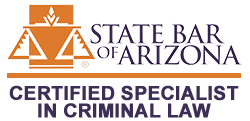Arizona Felony Sentencing Guidelines Updated for 2022

Arizona Felony Sentencing Guidelines
Arizona follows a statutorily created mandatory sentencing scheme for those charged with a felony offense. What this means is that in determining what an appropriate sentence is, a Court is required to sentence within a given range created by the legislature.
The felony sentencing charts, below, are helpful in that they show what potential penalties a person is facing. Keep in mind that determining where a person falls under the guidelines requires analysis by an experienced criminal defense attorney, like those at Gurion Legal.
If you find yourself charged with a felony and want to know exactly what you are looking at, obtain professional advice from a criminal defense lawyer and contact us at 480-800-0020.
Classification of an Arizona Felony
In order to determine what range a judge will be bound by, a Court must determine what class of felony a particular offense is. Arizona classifies felonies from 1 to 6, with 1 being the most serious and 6 the least.
Class 1 felonies have a sentencing scheme apart from other offenses, discussed further below. “Regular” felonies are controlled by Arizona Revised Statutes (“ARS”) 13-702 and 703. Offenses that are “dangerous” are covered by ARS 13-704, and those that are “dangerous crimes against children” are covered by ARS 13-705.
Class 1 Felonies
There are two Class 1 Felonies: first-degree murder and second-degree murder. First-Degree Murder carries possible sentences of life in prison or the death penalty. The sentence for First-Degree Murder is controlled by ARS 13-751 and 13-752. Second-Degree Murder carries a possible punishment of 10 to 26 flat years in prison.
A “flat” sentence means that you serve every day of the sentence, and it cannot be shortened. The sentence for Second-Degree Murder is governed by ARS 13-710.
“Regular” Felonies
Regular felonies, those that are non-dangerous and range from Class 2 to 6 are further categorized into four separate categories. The first category is the “first offense” category, and is special because with a few exceptions, these offenses are eligible for probation.
The potential sentencing ranges are listed in this chart:
The “Presumptive” sentence is where the Court is presumed to start. In order to sentence above the presumptive sentence, a Court must find the presence of at least one aggravating factors. Aggravating factors are listed out in ARS 13-701(D). To sentence below the presumptive sentence, a Court must find the presence of at least one mitigating factor.
Mitigating factors are listed out in ARS 13-701(E). Your attorney can help you present mitigating factors to try and outweigh any aggravating factors offered by the State at the time of sentencing.
An experienced criminal defense attorney will be able to collect the information and argue effectively on your behalf.

If you have prior felony convictions, then your situation may be more serious. A lot depends on whether your prior felony conviction is a “historical prior felony conviction.” Historical prior felony convictions, defined in ARS 13-105, are class 2-3 felonies committed in the last 10 years; class 4-6 felonies committed in the last 5 years; drug offenses requiring mandatory imprisonment; dangerous offenses; aggravating driving under the influence; illegal control of a criminal enterprise; and any dangerous crime against children.
If you have one prior felony conviction that is not a historical prior felony conviction, then you fall into Category 1 and face the following sentencing ranges:
Unlike a first-offense felony, probation is not possible.
If you have two or more prior felonies that are not historical prior felony convictions; or one historical prior felony conviction; or are charged with three or more separate offenses in the same charging document but occurring on different dates of offense, then you will be placed in Category 2 and face the following sentencing range:
If you have two or more historical prior felony convictions, then you will be placed in Category 3 and face the following sentencing range:

“Dangerous Felonies”
The guidelines for “Dangerous” felonies is different than “regular” felonies. A Dangerous felony is defined by ARS 13-105 as one that involves the use, discharge, or threatening exhibition of a deadly weapon or a dangerous instrument; or the intentional or knowing infliction of serious physical injury on another person.
Typical dangerous offenses are manslaughter, aggravated assault with a weapon, armed robbery, arson, discharging a firearm within city limits, and others. ARS 13-704 controls the sentencing for Dangerous felonies.
As with regular felonies, having historical prior felony convictions increases the sentencing range; however, those historical prior felony convictions must also be dangerous. A first-time dangerous felony carries the following sentencing range:
Having one dangerous historical prior felony conviction increases the range as follows:
Having two or more dangerous historical prior felony convictions increases the range to the following:
Dangerous Crimes Against Children
ARS 13-705 categorizes dangerous crimes against children into 6 different categories. For a first-time offender, the ranges are as follows:
Some offenses falling under 13-705(E) and 13-705(F) are eligible for probation with a length up to lifetime. In addition, dangerous crimes against children often carry the requirement to register as a sex offender for life.
If a person is convicted of a dangerous crime against children and has a predicate prior offense, then the range increases as follows:
If a person has two predicate prior offenses, then the range increases as follows:
Getting Sentenced for a Felony Conviction
While the sentencing charts are instructive, they are not the whole story. Certain offenses require either mandatory prison time even for a first-time offender, and others require additional time be served on top of the sentence chosen by the Court.
Other times the state can file allegations that if proven require a Court to sentence to no less than the presumptive sentence, or to revoke probation, or to add more time to a sentence. In addition, certain offenses require flat, or day-for-day sentences, while others are eligible for release after 70% of a sentence is served, or 85% of a sentence.
An aggressive Arizona felony attorney can negotiate away some allegations of prior convictions or other things that increase your sentence and attempt to mitigate the damage by presenting evidence about your life.
Depending on your case, there may be a way to fight and win, despite the harsh possible sentences. If you are charged with a felony, do not wait – contact an experienced, aggressive, and effective criminal defense attorney. You need to contact Gurion Legal.

